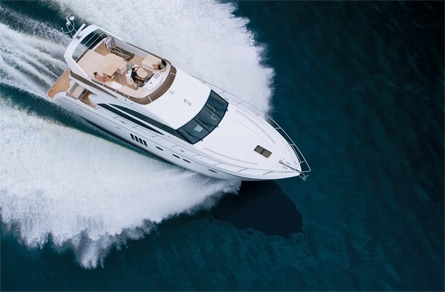
viking63445.jpg
A motoryacht that can perform impeccably in howling winds and nasty looking waves in a cold, gray sea still impresses this old salt. When this motoryacht is dripping with luxury appointments and superior cruising details, I encourage all serious yachtsmen to stand up and give applause.
The Viking Sport Cruisers 63 is the latest addition to the series, the offspring of a 12-year collaboration with Princess Yachts International, the largest boatbuilder in Britain, and New Jersey-based Viking Yachts. There is something sublimely British about the 63’s design. The restrained style is dignified, yet with a pleasing wink toward the modern. The concept follows a classic style, owing little to fashions, providing confidence that in 10 years the 63 will still command attention.
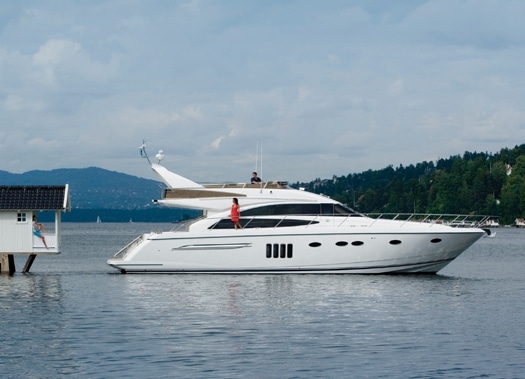
| | |
Below the surface, designer Bernard Olesinski developed an innovative hull form. The basic concept is a deep-V with a fine entry, but with plenty of volume. The propellers are recessed into tunnels. This is where the interest starts. The tunnels rise up to what looks like a skeg at the transom. Then they flatten out at the top before curving down to rejoin the “V” of the hull not far from the chine line. Although this semi-skeg fits into the envelope of the deep-V, it gives the hull excellent directional stability-something that allows the 63 to run straight and true in a considerable following sea. The pronounced spray rails help break up the waves before they strike the chine, providing a dry, comfortable ride even in the rough sea state we experienced.
Besides the hull design, another small example of the research and development that goes into a Viking Sport Cruisers is revealed by the flying bridge venturi. It would have been easier to install the type of reverse angle venturi favored by many builders, but Viking conducted wind tunnel tests to find a shape that really works. This resulted in a curved reverse angle that does a fine job of keeping the wind under control even during our blustery outing.
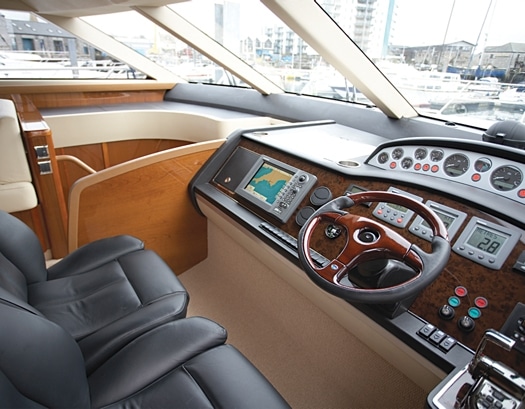
| | |
Other areas of the flying bridge are designed to offer a comfortable life on sunnier days with settees, tables, and a sunpad abaft the helm. A grill and wet bar will serve your hungry crew. Above, the radar arch will accommodate a wide array of electronics.
The aft docking stations each have their own electric capstan to help with line handling and there are built-in line stowage bins alongside. Farther aft is the wide swim platform that accommodates the tender. A davit is built into the transom for launch and recovery of the tender.
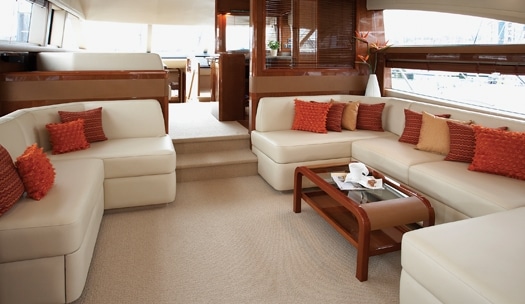
| | |
In fine weather, the saloon and cockpit combine to form a seamless level of living. In the saloon, the conservative styling is emphasized by the rather neutral colors of our test boat, but Viking’s interior design team can jazz up your 63 if desired.
The high-gloss cherry paneling and trim is traditional and it looks particularly good in the galley, which is virtually open to the dining area. All appliances are to U.S. specifications. There is a dining table adjacent to the galley counter and a wide enough passage between them for easy movement about the yacht.
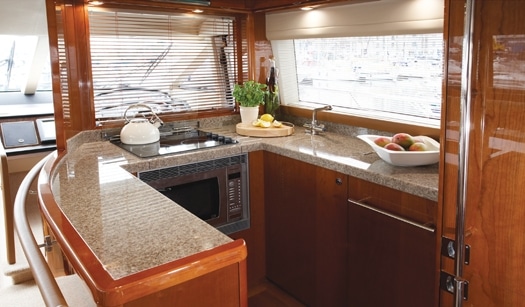
| | |
Privacy in the master stateroom is enhanced by a separate stairway. Four vertical windows on each side give excellent natural light. It rivals a hotel suite with a settee by the windows on one side and a combined desk and vanity on the other. The en suite head is large and has a separate shower stall.
Moving forward there is a twin cabin tucked in on the port side that can be specified as an optional office. The remaining portion of the layout is cast in stone, featuring a twin cabin on the starboard side and the VIP stateroom in the bow. The VIP is particularly attractive with the portholes framed in cherry and an inviting double berth. Both cabins have large en suite heads. Tucked away outside the master is a locker with a washer and dryer.
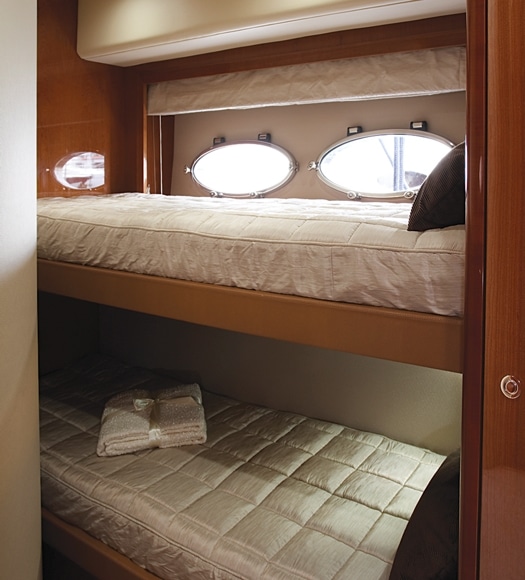
| | |
Optional crew quarters can be specified under the afterdeck. On our test boat, this area was left empty creating a large lazarette. This was opened up to make it common with the auxiliary machinery space where the generator and other equipment are housed. Forward again is the engineroom with cockpit deck access. Here, it is a bit tight with the two large MAN diesels taking up most of the space. However, there is access to all the important bits, so I have no real complaints on that score. The test boat had the larger of the two power options with 2,200 hp on tap offering a top speed of 32 knots.
I applaud this yacht for its clean, functional lines, its superb performance in difficult seas, and its timeless character. This is a rare combination in a world where fashion tends to rule. You don’t buy a Viking Sport Cruiser as just a fashion icon; you buy it as an investment in pleasure that will give you years of safe, comfortable family cruising.
Contact: (609) 296-6000; www.vikingsportcruisers.com









